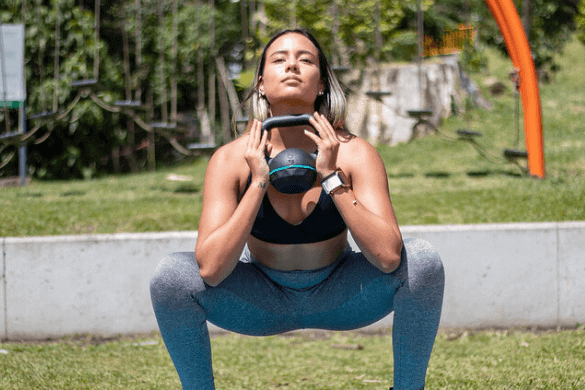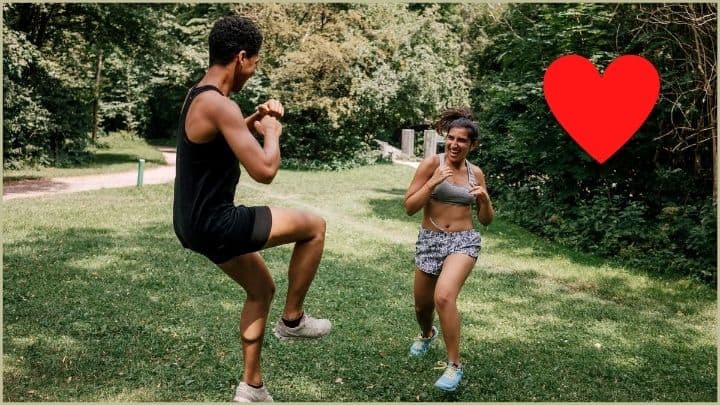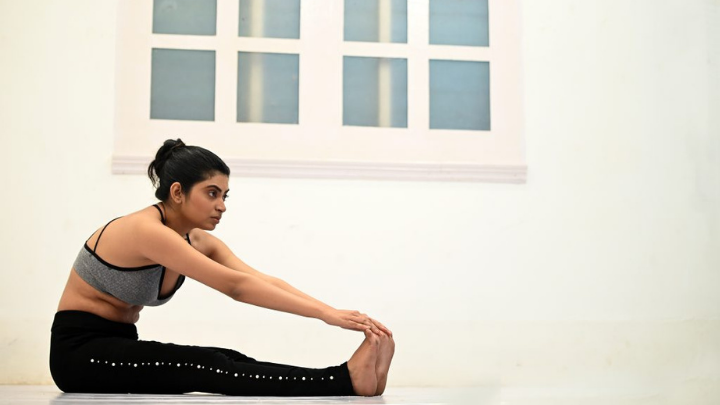Through a variety of online media and video, people all around the world are able to try a yoga class for the first time and maintain a personal yoga practice from the privacy of their own home, while others may prefer to do yoga in the company of other practitioners at a yoga studio.
The seemingly endless choices in how and where you access your yoga, in addition to all the different styles of yoga available, play a big part in how much “fun” you can have—or not have—doing yoga, whether you’re a beginner or a seasoned practitioner.
Let’s jump right in… Can yoga be fun to do?
Yoga can be fun to do but it depends primarily on YOU: your attitude, your dedication, your commitment and your consistency. Whether or not yoga is fun can be influenced by external factors like your yoga instructor, your yoga community and your yoga practice space and equipment.
Why Can Yoga Be Fun?
“Happiness is a state of mind.” – Dalai Lama XIV
Now, let’s jump right into exploring how and why yoga in particular can be a fun form of exercise.
First, let’s define “fun” from a fitness point of view: Exercise like yoga is “fun” when you enjoy doing it. If you look forward to exercising, then it can be fun.
In his book The Fun Habit: How The Disciplined Pursuit of Joy And Wonder Can Change Your Life, psychologist Mike Rucker further defines “fun” as doing something active and intentional, often involving sensory experiences and interactions with other people. “Fun,” he writes, “is something you choose for yourself, and can give a thrill that transcends the ordinary.”
The best part? Having fun doesn’t require education or power. Rucker points out in his book how fun is something you intentionally do. All it requires is going out there and seeking experiences.
Catherine Price, science journalist who published The Power of Fun in 2021, says fun shouldn’t be trivialized. “It is essential for our happiness and health,” she states.
Let’s dive deeper into…
6 Reasons Why Yoga Can Be Fun
1. Mindset
Yoga can be fun when you have a positive attitude and an open mind, being open to a new experience every time you unroll your yoga mat, even if you have been practicing yoga for years.
First, you must make up your mind that you want to feel good physically, mentally, emotionally and spiritually. With this mindset, you can approach your yoga knowing that your practice will bring you benefits.
As author Mike Rucker points out in his book about fun, when you are willing to go out there and try something new, you increase your chances of having an experience that brings you satisfaction, happiness and joy.
Now: this depends on your attitude in the first place. Attitude. Are you open to trying something new? Can you approach your yoga practice with a “child’s mind”—trying it as if it were the first time ever, experiencing each posture with no expectation of the results?
A fundamental principle in yoga known as Vairagya, detaching from the results of your efforts, helps you let go of negative emotions and limiting beliefs. Joy comes from just showing up and being present in the moment.
I am a seasoned practitioner and instructor of yoga with over 25 years of consistent, daily practice. So, how do I keep doing yoga every day for so many years without getting bored? Simple. It’s attitude. I let go of my expectations of doing it “right”, of getting certain results, of being able to do every posture the same way I did them yesterday.
I unroll my yoga mat with an open mind to having a new and different experience that nourishes my body, mind and spirit.
In yoga, “trying something new” could mean going to a yoga class for the first time, trying a different yoga studio or trying a new teacher, whether in person or online.
Even something as simple as getting a new yoga mat or a new pair of colorful, comfortable yoga pants can infuse your yoga practice with a sense of novelty, making it more fun.
Did you know? You can change up your yoga practice routine. Why not? If you can change your wardrobe or your hairstyle, then you can change how you practice yoga based on personal needs and preferences. Consider trying a new sequence of postures to keep your practice interesting.
The best part: You can change up your yoga practice routine based on your energy level. There are numerous different styles of yoga out there to fit most everybody’s needs.
For example, if you’re feeling a bit sluggish, you may benefit from doing an energizing, more rigorous style of yoga like Vinyasa or Ashtanga. If you’re feeling stressed out or anxious, you may benefit from a slower-paced, relaxing style like Yin Yoga or Restorative Yoga.
Remember, your body changes as you develop muscle strength and flexibility through yoga, so you may need to change your yoga posture routine in order to take your practice to the next level of challenge for your body’s size, shape and capabilities.
And it gets better: Doing yoga becomes easier the longer you practice, because over time you develop your strength, flexibility and concentration.
Having fun is all about seeking experiences. So, don’t be afraid to go out on a limb and have a little fun!
2. Dedication and Commitment
“Freedom is not the absence of commitments, but the ability to choose – and commit myself to – what is best for me.” –Paulo Coelho
It’s one thing to try a new class. But you take your practice to a whole new level by making a commitment to do yoga regularly. Dedication to your personal health and wellness can bring the results you want to see, whether you’re keen on weight loss, more flexibility or less stress.
Setting a personal fitness goal that is realistic and attainable can make your yoga fun, because you will be more motivated to practice as you see yourself making progress.
3. Consistency
I am a Certified Yoga Teacher with over 25 years of experience teaching yoga classes to all ages and body types. Currently, I teach weekly classes to university students and professors who have full class loads and busy schedules.
Over the course of several years teaching yoga at the university, I have observed the people who come to class on a regular basis (at least once a week) make the most progress and report greater results on their end-of-semester class evaluations.
For example, one university student who came to class every week this past semester wrote on her evaluation form, “Yoga helped me pass my exams. I learned how to manage stress and relax my body and mind.”
Even when it’s tough to make time for your yoga, it’s worth the effort. Consistent practice is the key to making progress, achieving your goals, and experiencing the benefits of yoga.
4. Building Community
Going to a yoga class can give you the opportunity to meet people with similar interests and values.
Yoga can be fun when you make new friends, get to know them and spend quality time together doing something enjoyable, especially one that involves all your senses.
A yoga teacher friend of mine who owns her own yoga studio invites her students to sit and have tea after class. She says this ritual has allowed the participants to make new friends, get to know each other and bond by sharing their experiences.
If you prefer to practice in the privacy and comfort of your own home, there are also several online yoga communities. You can still build your community of friends in an online format. Interaction in live chats may be a safe, non-intrusive way of asking questions and getting useful feedback about your yoga practice.
5. Yoga Instructor
Your yoga instructor can make a big difference in your enjoying a yoga class, whether it’s online or in person at a yoga studio.
Yoga is a form of exercise that has traditionally been passed down through the generations. For this reason, a teacher “transmits” his or her knowledge, insights, and expertise to the students.
Does your instructor provide high-quality instruction and feedback? Do you feel comfortable and safe with your teacher? Depending on your teacher’s training in yoga and years of experience teaching and actually practicing yoga, your yoga teacher plays a big part in how much you can get out of a yoga class.
6. Your yoga practice space and equipment
I tell my students, “The best thing about yoga: All you need is your body and a flat space free of distractions.”
Cutting out distractions has become increasingly challenging in our modern world. First, I recommend turning off your cell phone so you won’t be distracted by any sounds from notifications, texts, or calls.
Where you do yoga can impact how much fun you have doing it. Being in a beautiful setting surrounded by nature may be more inspirational and motivating than being indoors.
Consider listening to calm, soothing music to accompany your yoga practice. Or you may prefer a more upbeat rhythm to motivate you, depending on the style of yoga you are doing.
Some people prefer to practice in the privacy and comfort of their own home, especially if you are taking a class online. Yoga at home can be fun if you set up your space to be conducive to your practice: the lighting, ambient sounds, reducing distractions, and strategically choosing the right time of day ideal for your yoga practice.
The brand and quality of your yoga mat and props, as well as your actual exercise clothing, contribute to how much enjoyment you can get from doing yoga, because these factors impact your comfort level.
There are a wide variety of yoga mats available. In my bilingual yoga classes in southern Mexico, I use “petates”—woven straw mats handmade by local artisans. If you are environmentally conscious, you may prefer to use a mat made of recycled materials.
Yoga mats come in varying thicknesses, from lightweight and thin to heavy and thick. The thicker your mat, the more challenging it is to do balancing postures, like standing on one foot in Tree Pose. However, a thicker mat can give you more comfort in reclined or kneeling postures like Camel Pose.
The thinner your mat, the more portable and easier it is to do standing balance postures like Warrior III Pose. However, you may find a thin mat to be uncomfortable in reclined postures like Corpse Pose (Savasana).
Why Can Yoga Not Be Fun?
Let’s face it. Just like life, yoga can sometimes not be fun. Some days you’re just not feeling up to it.
But knowing why you’re not having fun could be the way to switching things up a bit so you can have fun doing yoga, no matter how much you would rather just take a nap or eat ice cream instead.
1. Stinking Thinking
“Stinking thinking” is the number 1 reason why yoga can sometimes not be fun—a negative, “I can’t do it” attitude. A negative mindset puts a damper on your ability to have fun and enjoy doing yoga.
Doubting your ability to make progress may be one reason why yoga can sometimes not be fun. If you approach your yoga practice with the negative attitude that you won’t be able to make progress (I’m too old, too fat, too lazy, too fill-in-the-blank), then doing yoga may not be very much fun.
Being judgmental about yourself or others could be a downer and make yoga not so fun. This may also lead to self-isolation, cutting out your opportunity to make new friends and enjoy a sensory experience with others.
In addition to teaching and practicing yoga for over 20 years, I am a full-time bilingual classroom teacher. The teaching profession can be stressful and demanding. There are some days when I just don’t feel like doing yoga or any other form of exercise, because I’m stressed out or overwhelmed by work responsibilities.
What if you’re just plain tired or exhausted? A recent study showed that 30% of adults worldwide suffer from sleep disorders. Researchers concluded that insufficient sleep causes adverse physiological dysfunctions and increases stress.
When you’re stressed out, worried or anxious, it can be difficult to find motivation and maintain a positive outlook.
So, what should you do when you catch yourself in “stinking thinking”? I suggest an easy 3-step process.
Step 1 – Smile. Unroll your yoga mat in spite of yourself. Turn your “no-can-do” into “I can do it”.
Step 2 – Do your favorite yoga posture. And do it quickly. Don’t delay. If you’re not sure what posture to do, then skip to #3.
Step 3 – Take some deep breaths. Simple as that. Studies show that slow, deep breathing has many physiological benefits, including decreased anxiety and increased relaxation.
You’ll be surprised how much better you feel as soon as you do these 3 simple actions.
2. Stuck in a Rut
Yoga has many benefits, but not every posture or yoga style is a good fit for everybody. Avoid getting stuck in a rut, like falling into an inappropriate or overly repetitive practice routine.
I always encourage my yoga students to take a bit of a risk and try different teachers at different locations.
“Every teacher has something special and unique to offer you as a student,” I remind them, “so get out there and look around. Try on different teachers just like you try on different yoga pants, until you find the right fit for you.”
Getting stuck in a yoga practice rut, whether it be your practice location, teacher or style, can lead to lack of motivation, resulting in stagnated or diminished progress in achieving your fitness goals.
3. Stopping and Starting
Try to find consistency in your practice to avoid the pitfall of “stops and starts”. For example, on Monday you get up early and do an hour-long yoga session, then on Tuesday you press “snooze” and sleep in, and so on. Instead, consider the benefits of a consistent practice at the same time for a specific number of days each week—and stick to it.
Lack of consistency impedes progress in yoga and prevents you from the experience of what some teachers call “practice ease”—gliding right into your yoga with little to no effort. Finding ease in your practice can only come from consistency.
Avoid self-sabotaging your own progress by falling into counter-productive, unhealthy habits, whether it be poor diet, lack of time management or negative self-talk. Unhealthy habits can be the main reason why you start yoga one day and skip it the next, especially if you approach your practice with a negative, “I can’t do it” attitude.
Sometimes all it takes it to simply unroll your yoga mat, get down on the floor and do one of your favorite yoga postures for starters. The key is to step on your mat with a “can-do” attitude and have the mindset of a beginner every day.
World-renowned yoga teacher Bikram Choudhury said, “You’re never too old, never too bad, never too late and never too sick to start from scratch once again.”
4. Distractions
Globally, the average person uses up two to three hours on social media per day.
Technology, although useful in some contexts, can be the enemy of fun—enjoying the present moment. If you’re always distracted by your phone, checking your texts, then you’re not present with your body or your surroundings.
An unfocused yoga practice robs you of one of yoga’s greatest benefits: relief from stress. At the beginning of all my yoga classes, I gently remind my students to please turn off or silence their cell phones.
If you do need to take that call or respond to a text during your yoga session, then consider the other people in the room as well as your teacher. It may be appropriate—and more respectful—to step outside the yoga space while using your cell phone.
5. Unskilled Yoga Instructor
A yoga instructor should be certified to provide safe, quality classes and guide students. Check your instructor’s qualifications and experience. Ask them, “How long have you been doing yoga?”
Years of experience doing yoga is more valuable than whether or not someone is certified to teach yoga, although certification is important. Certification programs are designed to train teachers in how to give quality instruction and feedback to their students.
Remember the adage, “Don’t judge a book by its cover.” This applies to finding a good yoga teacher: Avoid being overly impressed by outward appearances or charismatic personalities.
Ask other students and people in your community about your teacher. Are they respected in their communities? Have any of their students ever been injured? What is their track record? How do you feel when you’re in their company? Pay attention to any red flags.
Find a teacher who makes you feel 100% comfortable and provides a safe, professional, nurturing environment. Keep in mind that yoga is not just a physical practice; it’s a holistic mind-body-spirit discipline, so yoga teachers should model and emulate these qualities to the best of their ability.
Many weekend certification programs are now available that provide a certificate, and some of these may even be taken online. While these “crash courses” may provide a good introduction to yoga, one weekend is not enough time for anyone to deepen their practice or understanding of the benefits of yoga.
The more experience an instructor has doing their own yoga, the better they can lead and guide you in your own practice, helping you deepen your understanding and make progress.
6. Inadequate Yoga Practice Space or Equipment
Maybe it’s not the music or the yoga pants or having the right brand of yoga mat. Maybe it’s the setting itself. Where you do your yoga can play a big part in whether or not you can enjoy yourself.
One student of mine complained that she stopped doing yoga over holiday vacation. “I couldn’t do yoga at home,” she said, “I was too distracted”.
I asked her where in her house she was practicing yoga. “Well, in my living room,” she said, “with my dog and my roommates watching Netflix…”
I suggested that she could find a quieter spot in her house or try practicing at a time of day when nobody else was around. The next week, she reported a more positive experience. She said, “I changed to my bedroom during midday when my roommates are out to lunch, and I put my dog outside.”
Avoid doing yoga in a cluttered, distracting environment.
Sometimes, the quality of your yoga mat and exercise clothing does make or break your yoga practice. The thickness of your mat, for example, can determine whether or not certain postures feel uncomfortable.
While yoga clothing should ideally be fitted, clothing that is too tight, especially around the belly and chest area, can make your practice uncomfortable. Try different sizes and brands until you find one that fits you best.
I suggest varying the thickness of your mat by doubling one on top of the other, and see what works best for you. Some people prefer thick mats, while others prefer thinner for more ease in balancing postures.
Frequently Asked Yoga Questions
Grab a new mat at the exercise equipment store, call a friend and invite them over to practice an online video yoga session with you or try a new yoga studio.
Make your yoga work for YOU. And have fun doing it!
The most fun yoga is the yoga that YOU enjoy doing the most. The good news: There are many different, unique styles you can try to spice up your yoga practice, both online and at a yoga studio in the company of other practitioners.
Here are two fun types of yoga you can do with your furry, four-legged friends:
– Goat Yoga
– Dog Yoga (Doga)
If you’re into dancing, swinging or hanging upside down, try these yoga classes:
– Yoga Raves
– Aerial Yoga
For the adventurous at heart, consider spicing up your yoga practice here:
– Nude Yoga (Noga)
– Ganja Yoga
Feeling emotional and need to let it out? Try this (yes, it’s a real thing):
– Tantrum Yoga
– Laughter Yoga
– A clinical study found that 12 weeks of consistent yoga practice improved muscular strength and endurance, flexibility and cardiorespiratory endurance in adult participants.
– Yoga helps you improve balance by strengthening and stabilizing your core, like when you stand on one leg in Tree Pose
– Yoga postures, especially inversions and twists, increase your blood flow and circulation, improving cardiovascular health.
– This study showed that older adults who practiced yoga consistently for a year reduced high blood pressure.
– Yoga postures allow you to mobilize, lubricate and decompress your joints while at the same time strengthening your muscles, helping you prevent injury. Over time, your yoga practice can help ease muscle tension and avoid chronic pain in your back, shoulders and hips.
– Yoga helps you breathe more deeply than normal. Yoga includes many different breathing exercises called Pranayama.
– Yoga breathing exercises require you to focus your attention on taking deeper inhales and exhales, calming your nervous system. This study showed that deep breathing has many psychophysiological benefits for your body and mind, including increased lung capacity.
– Scientific studies show that yoga helps reduce stress by decreasing your body’s level of cortisol, a primary stress hormone for fight-or-flight. Yoga postures and breathing exercises activate a relaxation response in your body, helping you relax and feel less stressed.
While yoga has so many benefits on a physical, mental, emotional and spiritual level, it does requires time and commitment on your part.
Yoga is not a “quick fix” that you can easily administer like an over-the-counter drug. It is a discipline that challenges you to show up fully.
Keep in mind that there are some contraindications to yoga for certain physical conditions and specific postures.
A well-trained yoga teacher should be able to give this information to students when needed and offer modifications to help you feel more comfortable.
Contraindications to Yoga:
– Surgery
– Hypertension
– Lower back pain
– Frozen shoulder or injury
– Knee pain
– Sciatica
– Pregnancy
1. Yoga is over 5000 years old and is one of the oldest known physical disciplines in the world.
2. Yoga is a combination of meditation, breathing, and postures.
3. The Rig-Veda, one of the oldest texts in the world, otherwise known as “praise of knowledge,” contains elements of yoga.
4. Practicing the “eight limbs of yoga” will help you gain a deeper understanding of the ancient roots of yoga as it was originally designed.
5. The best-selling book about yoga available in the English language is Light of Yoga by B.K.S. Iyengar.
6. Yoga was introduced to America in the 18th century.
7. There are more than 100 styles of yoga.
8. Yoga may increase your life span, because it facilitates deeper breathing, greater lung capacity and provides benefits to your cardiovascular system.
9. Yoga involves slow, rhythmic breathing, because the ancient yogis who designed yoga believed we have a limited number of breaths in our lives, and slow breathing can help extend our life.
10. Yoga can help reduce depression.
Conclusion
YOU are what makes your yoga fun: your mindset, your dedication, your commitment and your consistency.
While external factors like your yoga instructor, yoga community and yoga practice space and equipment are reasons why yoga can sometimes not be fun, YOU have the power to transform your yoga practice into a positive, healthy and fun experience by trying the suggestions in this article.
Now I’d love to hear from you:
What makes yoga fun for you?
When are you going to try something new in your yoga practice?
Perhaps you’d like to share your experience with trying the suggestions in this article?
Let me know by leaving a comment below and remember to follow us on Instagram for more great content.






